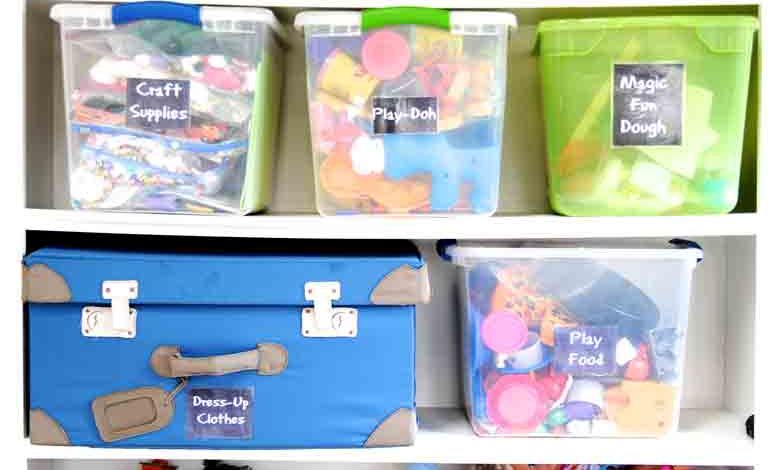5 Storage Ideas to Keep Your Kid’s Toys Organized Regularly

Bing toys and play items are phases of parenting people with kids have to pass through. It can be a delight watching your kids tap into their imaginative side while playing. But what isn’t so fun is having to organize their toys and playbook after they’re done. This can be a bit difficult because your child might have different interests, which means other toys.
Organization ideas for your kid’s toys should include toy boxes and other storage containers explicitly built for storing different toy parts. This will allow your child to be able to find the toy that they are looking for quickly. For younger children, you can buy organizers with drawers built right into them, and this will allow your child to put away their crayons, markers, pencils, and other messy supplies in the drawers.
You can purchase specially designed toy organizers that fit right on their beds or cabinets for older children. These organizers are usually made out of plastic and can either be lockable. If you can’t decide on which type of toy organizer is best, you can also choose a combination of different types. Here are some options to choose from.
Table of Contents
Group The Toys
Toy storage is easier if the toys are classified in to different categories and types. As a child, you learned about the importance of organization and sorting from putting your toys together. You can pass that on to your children as well. It is okay to keep all your kid’s toys and even buy more, but this is where rotation comes in handy. Store 1, 2, or 3 puzzles in the same area. The same thing goes for the other toys. This way, you don’t have to bring everything out when they want to play. Instead, store the rest in a labeled container.
Also, be mindful of your child’s playing environment. The playroom is more than just storage space. Add a floor or play rug to give your room a cozy feel.
Categorize Your Storage Containers
If you want to keep your kid’s toys from cluttering your house or simply want to make them easier to find when you need them, use suitable storage containers: plastic or wooden chests to store their toys. If you have a large number of hand-me-down toys from a variety of different age groups, it is easy to lose track and forget where they are all together. Instead, you can use other stackable boxes or containers with compartments to separate them.
The storage requirements for children’s toys vary by age. Back-up containers and boxes are ideal for dealing with large toys. Use your common sense to assign each toy to different categories. Use the Appropriate Storage Container
Storage containers come in all shapes and sizes. For example, if you are organizing a crowded playroom, you might want to buy storage bins to contain the mess that is sure to arise from playing. On the other hand, if you are looking for the perfect solution to organizing your children’s rooms or workspace, try to think outside of the box when it comes to storing your kid’s toys and belongings.
With so many different sizes available and with so many additional features and styles, you can find storage bins for just any kind of toy. In addition, many vendors offer stackable plastic containers to assist in making the most of small storage space or high cube units big enough to house big toys.
If you don’t have storage space, consider purchasing a basket or wicker basket to store your loose toys. Small baskets can be stored in corners or behind furniture. Knitted baskets are fun and can hold a wide variety of items. Your child can also get involved by learning how to use the cute wicker baskets to store their toys. Of course, a large storage chest is also perfect for toys!
For most families, buying small plastic containers is very important. To help children understand their purpose, you can name each container with a word or image. Containers with uniform lids can be placed on shelves and cabinets so that they are not visible.
Declutter Regularly
Create a closet to store unused toys, a basement, or even an empty garage space. Use a trash can or bin to sort these toys by type and label their contents. When children are small, they have a lot of toys. Their interest in those toys might diminish as they grow older. A step-in decluttering is to donate the toys. Create the right organizational system for yourself and your space. For each type of toy or activity, having a unique container with the toy’s name increases the likelihood that children will keep the toy.
Children will prefer their belongings in a charming and simple place, making sure to buy colorful and decorative containers. The simpler the system, the easier it is for everyone to maintain.
Get Your Whole Family Involved
There are different toys to choose from, each with its advantages and disadvantages when it comes to organization. For example, some toys are meant to educate while others are meant just for playing. As your kids grow older, you should involve them in the organizational routines of their toys. This way, the burden won’t lie on your shoulders alone.
Children naturally want to be helpers. Showing your children how to arrange toys will make them feel like they are part of the process. It also helps to form expectations about the proper storage of toys. Of course, it takes twice as long to get to work, but the long-term benefits outweigh the short-term ones.
Conclusion
The number of toys in the house increases with every birthday and holiday, but even faster when more children join the family. Further, your home explodes with more chaos, and keeping things in check seems more difficult. Keep in mind that the organization and type of storage method you use depend entirely on the room you need to work in. If you have to deal with a small space, then you should buy your storage items accordingly.
Follow TechWaver for more Technology, Business News.

![Photo of Free Microsoft Office 2016 Product Key [Updated Jan 2024]](https://www.techwaver.com/wp-content/uploads/2020/06/Microsoft-Office-2016-390x220.png)

